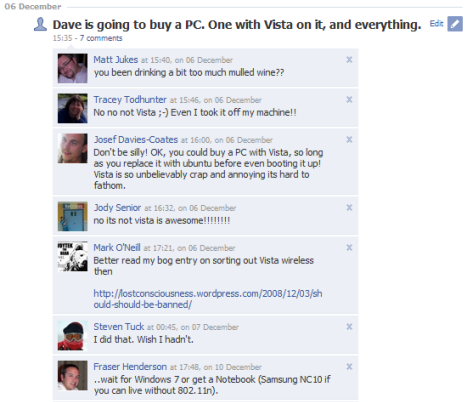Just recently, I have stopped using the WordPress inbuilt editor, which runs in the web browser, and have started using MarsEdit – a piece of desktop software I have previously been rather unkind about – to write my blog posts. Since getting a PC, just recently I have continued in this offline blogging vein by using Windows Live Writer.
This started me thinking about the ways I use online services – through web based or desktop applications. As always, the first thing I did was to ask my Twitter buddies:
- Me: What makes you decide whether to use a web app rather than a desktop one? eg webmail vs client, or google reader vs feedemon or netnewswire?
- Simon Wakeman: functionality functionality functionality…it depends, I use a mix of each, although my multi-PC multi-site work life lends itself to a cloud-based apps (newsgtr excepted)
- Nick Booth: experimentation or if someone shows me something I like – then I’ll use it.
- Matt Kelland: web apps are a last resort for me – only if I need collab access to the data AND I know I will always be online when I need it
- Kevin Campbell-Wright: I’m with Simon Wakeman
- Steven Tuck: using desktop for things where I want alerts eg twhirl, feeddeemon and web based for portability google docs, email.
- Andrew Beekan: Accessibility. When it comes to readers and mail I like to be able to access wherever I am. Docs, I use a mix of Office & Zoho.
- Michael Grimes: Because I can access them easily from anywhere (with an internet connection).
The answer, it appear, is ‘it depends’.
Let’s have a look at some examples of what I use and where.
Email
I use webmail all the time – Gmail in this case using Apps for your domain. However, I have also set up Apple’s Mail client to download my email through IMAP for backup purposes, which I do roughly once a week. The main advantage of using the client application on my desktop is that it works when I’m not online… but that is rarely the case and my iPhone can be used for emails that just can’t wait. So, I’m happy with webmail. Unless anyone wants to convince me otherwise?
News reading
I started out reading RSS feeds late 2004, using Bloglines (Google Reader didn’t even exist in those days…). Then, as a Windows man, I discovered the wonder that is FeedDemon, a desktop application that really is the Rolls Royce of aggregators. When Google Reader came out (for the second time, the first version was rubbish) I toyed with it for a while before returning to FeedDemon.
When I switched to a Mac, I immediately downloaded NetNewsWire, the equivalent to FeedDemon. Sadly, I found that it just wasn’t the same experience, both in terms of ease of use and features. So, I switched to Google Reader, and that was that.
(It’s worth pointing out that both FeedDemon and NetNewsWire are part of the Newsgator family of RSS products, including the online RSS reader. All three sync together, so you could use NNW on a Mac, FD on a PC and NG at a third machine, and all would be up to date with what you have read and what you haven’t. Pretty neat.)
I really got into some of the features of Reader, like sharing items, with and without comments, which get automatically re-reported in FriendFeed. I also have got used to using Google Gears to download an offline copy of my feeds to read on the train. So, am also a web-based man when it comes to RSS. I have, though, just reloaded my latest subscription list into NetNewsWire to give it another go – along with the iPhone app and the fact that I now have a PC with FeedDemon on it – which could convince me to switch back…possibly.
Blog writing
A quicky this as I seem to write about it so much – I prefer writing blog posts offline. It’s irrational in these days of always-on broadband, but I feel rushed using the built in WordPress editor. There’s more on this topic here. On a Mac, the only sensible choice of offline editor is MarsEdit, whose lack of rich text editing is, frankly, a strength. The only time I use the built in editor these days is when I am using a different machine to my MacBook, or if I need to use a lot of bullet points (which are a bit annoying to do in MarsEdit).
Twitter
I use a client for Twitter – Twhirl. Others may rant on about the benefits of others, like Tweetdeck (which is big and ugly and horrible in my view) but I have found Twhirl seems to do stuff just the way I’d expect and like it to. Which is more than can be said for the Twitter web interface, on the homepage. The brightest thing Twitter ever did was to outsource its UI, if the website is anything to go by…
Word processing
See blog posting. I just like typing into a desktop app more than a box on a web page. Even when the document I am writing needs to be shared, I’d still rather type it locally first, then upload to Google Docs or whatever. What are your thoughts on the online/offline decision? I’m clearly pretty confused about which I prefer and when!
Which do you prefer – doing everything in the browser, on the desktop or a bit of both?

